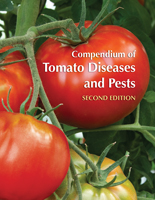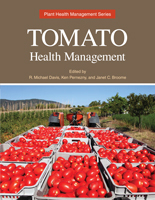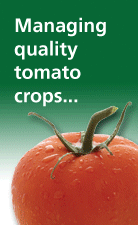Compendium of Tomato Diseases and Pests, Second Edition
Edited by: Jeffrey B. Jones, Thomas A. Zitter, M. Timur Momol, and Sally A. Miller
 Botanically speaking, tomato is a fruit. But by common understanding it is often considered a vegetable as well. Regardless of which term you use, tomato is the most “Googled” fruit and one of the most commonly grown.
Botanically speaking, tomato is a fruit. But by common understanding it is often considered a vegetable as well. Regardless of which term you use, tomato is the most “Googled” fruit and one of the most commonly grown.
Unfortunately, tomato plants are also a common target for many diseases and pests, affecting production for anyone growing the crop, including commercial producers trying to maximize yield and the small scale gardener who wants flawless and flavorful garden fresh tomatoes for salads, cooking, and canning.
Enter Compendium of Tomato Diseases and Pests, Second Edition. The nearly 250 images and associated information in this highly useful and significantly upgraded book allows anyone - from the gardener to professional - to identify, understand, diagnose, and treat more than 60 diseases of tomato occurring throughout the world. This impressive new handbook, written by expert plant pathologists working with this crop, includes nearly 20 new diseases and disorders, including those caused by fungi and oomycetes, bacteria, phytoplasmas, viruses and viroids.
The previous edition of this book was a top-10 best-seller in the APS Compendium Series and the new edition is even more useful with important coverage of arthropod pests: namely, mites, insects, and “worm” pests. The coverage of pests has been expanded significantly in this edition and includes the addition of 23 color photos from expert entomologists that illustrate these pests and the damage they cause.
This scientifically peer-reviewed information on numerous diseases and pests provides just the right amount of supporting information for users to make accurate decisions for disease and pest control. Throughout the Compendium of Tomato Diseases and Pests, Second Edition, disorders are both illustrated and discussed in sections that follow an easy-to-use and consistent structure: a statement of their importance and distribution, identification of common signs and symptoms, a description of their causal organism or agent, an explanation of their cycle and epidemiology, and recommendations for management.
This easy format allows the user to quickly identify signs and symptoms of important tomato diseases and pests occurring throughout the world—in the greenhouse, in the field or garden, and in transit to the market.
Individuals with a range of skill and expertise can use this book effectively, including field and greenhouse growers, home and master gardeners, consultants, horticulturalists, extension agents, entomologists, diagnosticians, plant pathologists, educators, and students. Those who work in postharvest channels, including tomato and canning storage facilities will also benefit from Compendium of Tomato Diseases, Second Edition.
Given its compact size, Compendium of Tomato Diseases and Pests, Second Edition can be taken directly to the affected tomato crop, where the pictures and symptom descriptions can be compared for diagnosis. Each individual description was written and each high-quality image was chosen by recognized scientists in the tomato industry. The expertise, thoroughness, portability, and simple format of this important book make it both a bargain and an essential tool for literally any tomato professional or enthusiast.
From the Preface
• The Introduction provides background information about tomato botany and culture, seed production and quality assurance, and container production of transplants. Among the new topics addressed are the change in nomenclature, in which the genus Lycopersicon was classified as Solanum section Lycopersicon, and the sequencing of the tomato genome.
• Part I outlines the infectious diseases that affect tomato—including those caused by fungi and oomycetes, bacteria, phytoplasmas, viruses, and viroids—along with postharvest diseases and disorders and diseases caused by nematodes. Each disease section has been updated from the first edition, and sections have been added to address approximately 20 new diseases and disorders.
• Part II covers arthropod pests: namely, mites, insects, and “worm” pests. The coverage of pests has been expanded significantly in this edition and includes the addition of 23 color photos that illustrate pests and the damage they cause.
• Part III examines noninfectious diseases, disorders, and damage: namely, physiological diseases, nutritional disorders, herbicide damage, and genetic diseases. This part now includes 40 color photos to assist readers in recognizing the damage caused by these various diseases and disorders, for which the signs and symptoms are often similar. The discussion of herbicides, in particular, has been updated to reflect the full range of available products.
• Part IV, which discusses diseases of undetermined etiology, has been reorganized to adopt the format used elsewhere in the book.
©2014; 8.5” × 11” softcover; 176 pages; 247 color images; 1 line drawing; 2 pounds; ISBN 978-0-89054-424-2
Tomato Health Managment
Edited by: R. Michael Davis, Ken Pernezny, and Janet C. Broome
 Tomato Health Management draws together the information that’s essential for the healthy production of both fresh-market and processing tomatoes. It covers every aspect of tomato production, including disease and pest control, cultural practices such as irrigation and fertilization, nutritional and other abiotic disorders, and postharvest quality.
Tomato Health Management draws together the information that’s essential for the healthy production of both fresh-market and processing tomatoes. It covers every aspect of tomato production, including disease and pest control, cultural practices such as irrigation and fertilization, nutritional and other abiotic disorders, and postharvest quality.
 Tomatoes are an intensely managed crop, and the production of high-quality, top-value yields is a substantial, often daunting challenge. Tomato Health Management helps meet that challenge by serving as a “one-stop” informational source for anyone interested in any step of the production cycle. Whether you need to know what cultivars to select, how to identify and treat a problem in the field or the greenhouse, or even what chlorination protocol best protects tomatoes after harvest, you will find the answer in this all-encompassing handbook. It provides science-based knowledge in an accessible format that will be readily useful to anyone in the tomato-production chain. From the greenhouse to the organic setting and beyond, this book describes management strategies that will help you avoid and overcome issues presented by weed and insect pests, diseases and abiotic disorders, and other concerns, such as plant selection, soil quality, storage, and appearance for market.
Tomatoes are an intensely managed crop, and the production of high-quality, top-value yields is a substantial, often daunting challenge. Tomato Health Management helps meet that challenge by serving as a “one-stop” informational source for anyone interested in any step of the production cycle. Whether you need to know what cultivars to select, how to identify and treat a problem in the field or the greenhouse, or even what chlorination protocol best protects tomatoes after harvest, you will find the answer in this all-encompassing handbook. It provides science-based knowledge in an accessible format that will be readily useful to anyone in the tomato-production chain. From the greenhouse to the organic setting and beyond, this book describes management strategies that will help you avoid and overcome issues presented by weed and insect pests, diseases and abiotic disorders, and other concerns, such as plant selection, soil quality, storage, and appearance for market.
Keeping tomatoes healthy is big business as the crop adds approximately $2 billion a year to the U.S. agricultural economy. This makes Tomato Health Management a valuable resource for the variety of professionals working in the tomato-production industry. The scientifically peer-reviewed information delivered in this book is synonymous with good management practices at all stages of production. By integrating those practices, the book explains how to plant, grow, harvest, and store tomatoes in labor-efficient, cost-effective ways and to simultaneously improve the health and value of your tomato crop.
Editors R. Michael Davis, Ken Pernezny, and Janet C. Broome have assembled a group of internationally recognized experts from the fields of soil science, weed science, nematology, plant pathology, entomology, and crop science—all key areas of applied tomato research and management. The editors have organized the book for ease of use and supplemented the text with high-quality color photographs and diagrams, quick-reference tables and boxes, and handy callouts of key concepts.
Rarely is such a broad range of cross-disciplinary topics covered in one integrated and convenient source. Tomato Health Management will be useful to growers, plant pathologists, crop-production specialists, diagnosticians, agronomists, regulatory agents, crop consultants, educators, researchers, extension professionals, tomato breeders, entomologists, horticulturists, weed scientists, county agents, master gardeners, and educators. This book will find a home tucked in the door of a pickup truck as easily as stored on the shelves of a comprehensive diagnostic lab or full-service library.
©2012; 8.5" x 11" softcover; 200 pages; 215 color images; 9 black and white illustrations; 2 pounds; ISBN 978-0-89054-402-0